

Tandberg countered the Nakamichi Dragon’s advances with its own innovations. It also developed a scheme called Nakamichi Auto Azimuth Correction, which used a microprocessor to control the position of the tape on the servo-controlled read head and make adjustments to achieve optimal alignment. The company employed a quartz clock to control the motors used to spool the tape. In the late 1970s and early 1980s, Nakamichi earned a reputation for quality with several innovations to control the advancement of the tape and achieve superior alignment. Feeding the tape over the head at a consistent speed was also necessary for the best sound. Through the 1970s, cassette manufacturers devised a number of ways to improve the tape itself to achieve better audio performance, but regardless of the formulation of the recording medium, getting the very best possible sound out of a cassette deck also required very precise alignment of the cassette tape as it advanced over the read head, an electromagnetic device a little smaller than a sugar cube. Photo:īut though they had convenience and recordability, what cassette tapes lacked, early on, was audio quality. Although reel-to-reel owners invented the notion of putting a personal mix of songs on a tape, the practice didn’t go mainstream until the 1970s, when cassette players became common stereo components.Įnter the Dragon: Nakamichi’s legendary tape deck used a microprocessor to control the position of the tape on the read head. The recordable cassette-tape format also popularized the mixtape, a cultural staple in the 1970s, 1980s, and 1990s. The combination made the Compact Cassette format a winner. Cassettes, on the other hand, were convenient and (eventually) hi-fi.
#CASSETTE TAPE DECK PORTABLE#
A short-lived rival format, the 8-track tape, was sort of portable but clunky and of dubious fidelity. LPs and reel-to-reel tapes were not portable, but cassettes were. In the 1970s and through the early 1990s, cassettes were one of the two most popular media types in the world, sharing the distinction first with LPs and then with compact discs (CDs). The Compact Cassette audiotape format was created in the early 1960s.

To understand the significance of this rivalry requires a bit of perspective on audiotape. The Norwegian company Tandberg responded one year later with the TCD 3014, a beast of a machine that was immediately hailed as the Dragon’s equal, if not more than that-hence, the “Dragon slayer.” That first Dragon set a new standard for high-performance tape decks. In 1983, the company introduced the Dragon, the first in a line that would share the name. dominated the market for high-end cassette players. Starting in the mid-1970s and continuing into the 1980s, Nakamichi Corp. We’re talking about the most highly regarded compact-cassette tape decks ever produced. No, we’re not getting all “Game of Thrones” on you. Once upon a time, there was a Dragon, and yea, verily, this Dragon dominated all the land, and thus it was, ’til one day appeared…the Dragon slayer.


 0 kommentar(er)
0 kommentar(er)
